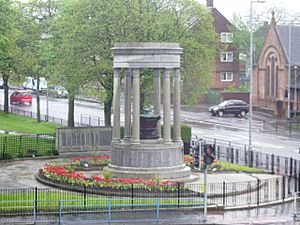Edith Hughes (architect) facts for kids
Quick facts for kids
Edith Hughes
|
|
|---|---|

Glasgow Mercat Cross (left), designed by Edith Hughes in 1930
|
|
| Born |
Edith Mary Burnet
7 July 1888 Edinburgh, Scotland
|
| Died | 28 August 1971 (aged 83) |
| Nationality | Scottish |
| Other names | Edith Mary Wardlaw Burnet Hughes |
| Alma mater | Gray's School of Art |
| Occupation | Architect |
| Spouse(s) | Thomas Harold Hughes |
| Children | 3 |
| Parent(s) | George Wardlaw Burnet, May Crudelius |
| Awards | the first woman nominated for membership of the Royal Institute of British Architects (RIBA), elected an Honorary Fellow of the RIAS in 1968, |
| Buildings | Glasgow Mercat Cross and Mercat Building |
Edith Mary Wardlaw Burnet Hughes was a Scottish architect. She is known as Britain's first female architect to start her own company. She opened her firm in 1920. She was born on July 7, 1888, and passed away on August 28, 1971.
Contents
Early Life and Learning
Edith Mary Burnet was born in Edinburgh, Scotland. Her mother was May Crudelius, and her father was George Wardlaw Burnet. He was a lawyer. When Edith was young, her family moved to Aberdeen.
Her grandmother, Mary Crudelius, worked hard for women's education. After her father died in 1901, Edith was raised by her uncle. Her uncle, John James Burnet, was a very famous architect. They lived in Glasgow.
Edith traveled around Europe to study art and architecture. She even attended classes at the Sorbonne in Paris. Around 1911, she joined Gray's School of Art in Aberdeen. She first studied how to design gardens. Later, she changed to architecture. She earned her architecture diploma in 1914. The next year, she became a teacher at the school. In 1918, she married her former teacher, Thomas Harold Hughes. He was also an architect.
Becoming an Architect
Edith and her husband wanted to work in her uncle's London office. But they were not allowed, partly because there was no restroom for women. However, her husband joined her uncle's Glasgow office in 1919. He later left to teach at the Glasgow School of Art. He became the head of architecture there.
Edith decided to start her own architecture business in Glasgow in 1920. This made her Britain's first female architect with her own firm.
Breaking Barriers
In 1927, Edith Hughes was the first woman ever suggested for membership in the Royal Institute of British Architects (RIBA). Her uncle, John Burnet, was one of the people who nominated her. But RIBA's rules said she could not join. The group remained all-male until 1938. Edith was also not allowed to join the Royal Incorporation of Architects in Scotland (RIAS) at first.
After World War II, Edith started her business again in Edinburgh. In 1968, she was finally honored by the RIAS. She became an Honorary Fellow of the group. She stopped working soon after this honor. Edith Hughes passed away in 1971. She is buried in Warriston Cemetery in Edinburgh.
Important Buildings and Designs
Edith Hughes worked on many different projects. She often designed homes and was very good at kitchen design.
Some of her public works include:
- The Coatbridge War Memorial (1924). This is a monument to remember soldiers.
- The Glasgow Mercat Cross (1930). This is a copy of an old market cross in Glasgow Cross.
She also made changes to the Glasgow Society of Lady Artists' building. In Edinburgh, she turned several large houses into flats. From 1956 to 1965, she worked on St Mary's Episcopal Cathedral and its Music School in Edinburgh. For the Cathedral, she designed a stone baptismal font and a beautiful iron screen for the Chapel of St Margaret of Scotland.
See also
In Spanish: Edith Hughes para niños



